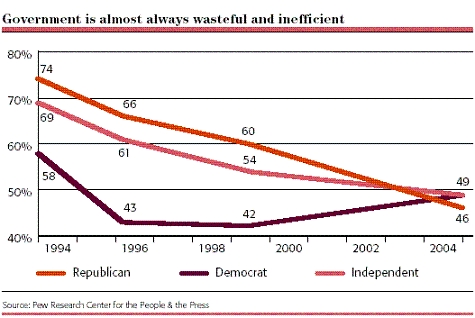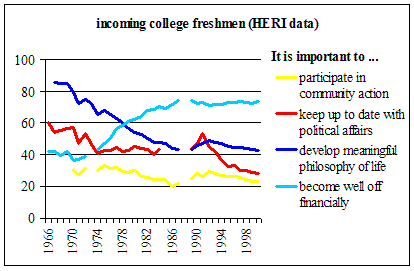This is a fascinating chart from the Pew Research Center’s “Trends” report.
Once upon a time, a Democrat was someone who believed that most existing government programs were worthwhile. A Republican was someone who thought that most government programs were a waste of money. There is now no difference between the parties on this question, although Democrats are slightly more likely to view federal programs as wasteful.
I suspect that Republican voters became more positive about government after the Clinton-era welfare reform, which ended the traditional federal subsidy to poor women with children. Perhaps they became even more positive once their party ran the government, and the most conspicuous federal programs became the “war on terror” and the invasion of Iraq (plus Social Security and Medicare)–all of which they support.
Conversely, Democratic voters don’t like the administration’s foreign policy adventures or the people in charge of them, and that may be part of the reason that they see government as wasteful. But here’s an additional hypothesis that would help explain the current weakness of the left. Many Democrats have come to see existing government programs–including welfare, education, health, and housing initiatives–as wasteful. This suspicion has a profound effect on politics; it means that a Democratic candidate cannot whole-heartedly or passionately advocate a different position from the Republicans’. Even his or her core constituency doesn’t believe that government programs really get good results. The best that Democrats can do is what Kerry did in ’04: talk vaguely about the need for health care reform, knowing pretty well than any particular legislation is dead on arrival. All that’s left is the ethical commitment to universal health insurance without any confidence that it can be achieved.
I see two main responses: (1) Democrats and liberals are simply demoralized, led into pessimism and cyncism by years of anti-state propaganda. They need to snap out of it–not just the leadership, but also the voters. Or (2) existing federal programs have a record of wastefulness and damage that has become too hard to ignore. We just can’t overlook farm subisidies, huge prisons, urban neighborhoods bulldozed by HUD, and even large school systems like the one my kid is in, with high per-pupil spending but insufficient money trickling down to classrooms. Furthermore, no one has shown us how federal money might solve problems like rust-belt unemployment, high crime and incarceration, or global poverty.
If (2) is true, the Democrats aren’t going anywhere until they develop bold and persuasive plans for reforming government.

